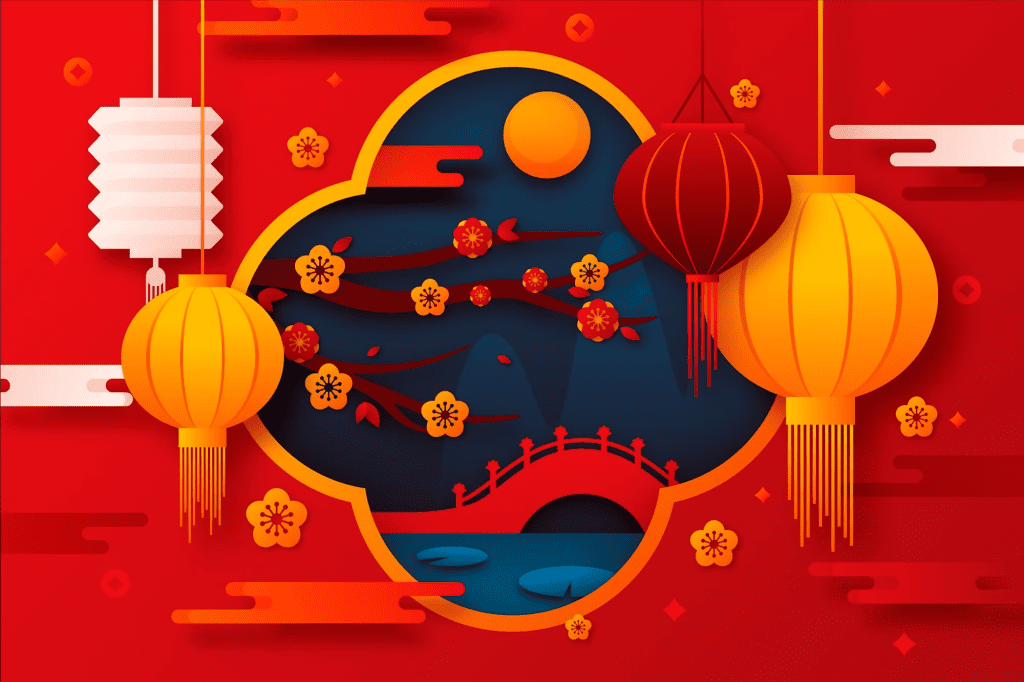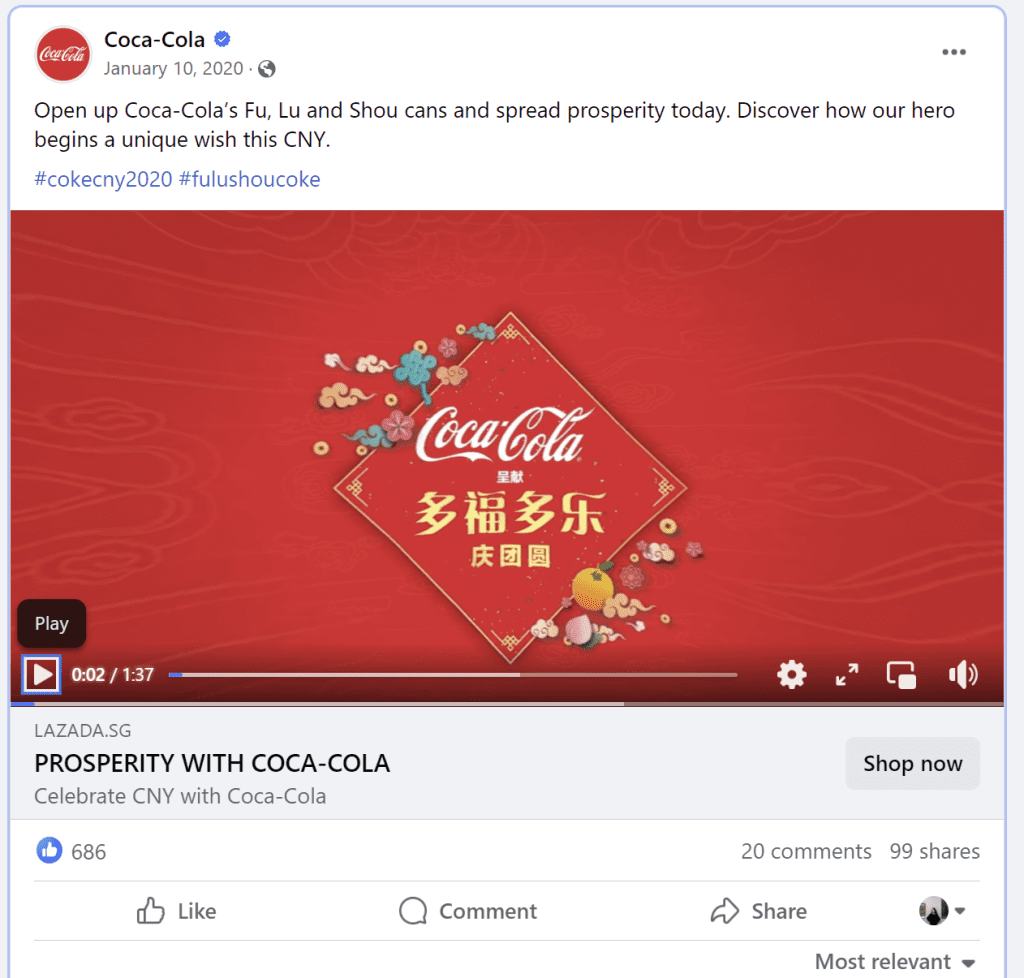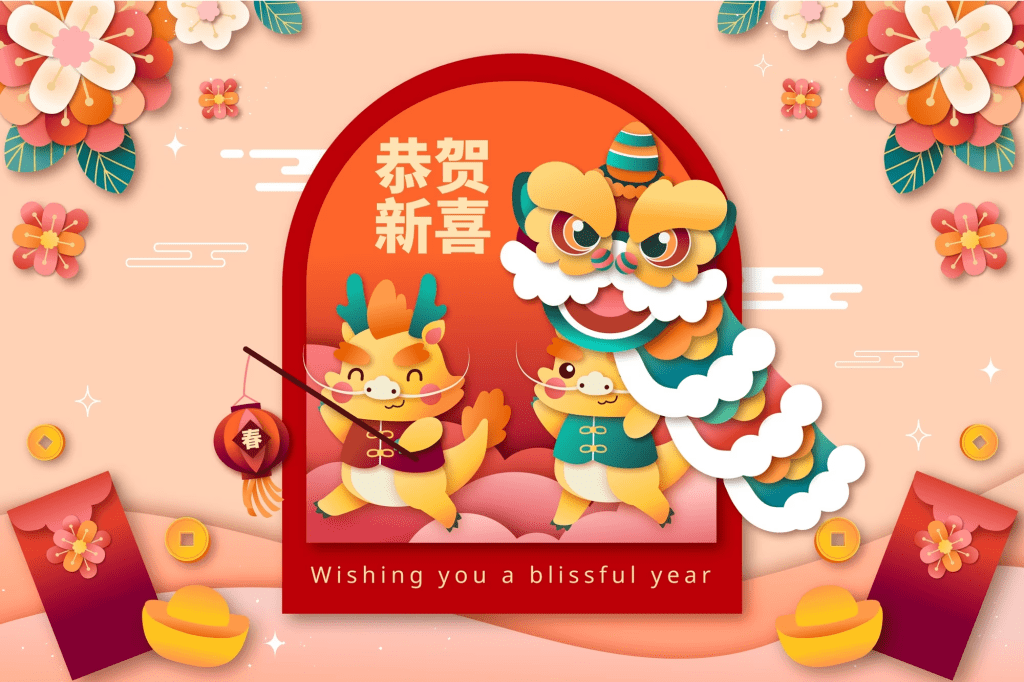Key Takeaways
- Cultural resonance is key: Tailor your Lunar New Year campaign with authenticity, aligning with traditions to create a meaningful connection with your audience.
- Strategic collaboration amplifies impact: Explore influencer partnerships, cross-industry collaborations, and tech integrations to expand your reach and influence in the festive market.
- Post-campaign insights shape future success: Analyze KPIs, gather customer feedback, and celebrate achievements to refine strategies and ensure a prosperous Lunar New Year in 2024 and beyond.”
Step into the vibrant world of the Lunar New Year as we unravel the secrets behind a robust strategic marketing plan for 2024. The Lunar New Year, synonymous with renewal and prosperity, offers an unparalleled avenue for businesses to engage with their audience.
In this comprehensive guide, we will embark on a journey that transcends cultural traditions, exploring innovative strategies to capture the essence of this auspicious occasion.
As businesses gear up for a fresh start in the Year of the Dragon, our aim is to empower you with insights and tactics that will set your marketing endeavors on a trajectory of success.

Understanding Lunar Landscapes: Tradition Meets Trends
To craft a successful Lunar New Year marketing plan, it’s imperative to understand the cultural landscapes and evolving trends that shape consumer behavior.
In this section, we will delve into the heart of Lunar New Year traditions, dissecting the elements that resonate with audiences.
Moreover, we’ll examine the current trends and shifts in consumer expectations during this festive season, providing a foundation for strategic decision-making.
By blending tradition with innovation, businesses can navigate the delicate balance of cultural relevance and contemporary appeal.
Setting Celestial Goals: Aim High, Soar Higher
A celestial marketing plan demands celestial goals. In this segment, we’ll guide you through the process of setting ambitious yet achievable marketing goals for the Lunar New Year in 2024.
Whether it’s revenue projections, brand positioning targets, or customer engagement objectives, we’ll equip you with the tools to outline a roadmap that aligns with your business aspirations.
As we aim for the stars, meticulous goal-setting becomes the gravitational force propelling your marketing endeavors toward unprecedented success.
Astrological Insights: Navigating Market Realms
Embark on a journey of astrological insights as we navigate the market realms during the Lunar New Year season.
Market research is the compass that guides strategic decisions, and we’ll explore how analyzing competitors’ Lunar New Year campaigns can provide valuable insights.
Additionally, understanding the preferences and behaviors of your target audience, coupled with an exploration of market trends, will empower your marketing plan with the foresight needed to outshine competitors and resonate with consumers.
Crafting Lunar Narratives: Themes that Transcend Time
In this section, we delve into the art of crafting Lunar New Year narratives that transcend time.
Choosing relevant themes and messaging is the cornerstone of a successful campaign, and we’ll provide insights into selecting themes that resonate with diverse audiences.
Furthermore, we’ll explore the integration of traditional elements into modern marketing approaches, ensuring that your narratives strike a chord with the cultural significance of the occasion while aligning with contemporary sensibilities.
Channeling Cosmic Energies: Selecting Marketing Channels
Navigate the cosmic energies of marketing by selecting the right channels for your Lunar New Year campaigns. Whether it’s digital, traditional, or social media, each channel offers a unique way to connect with your audience.
We’ll explore the strengths and nuances of each, guiding you to make informed decisions that align with your brand and campaign objectives. As we harness these cosmic energies, your message will resonate across platforms, reaching and captivating a diverse audience.
But, before we venture further, we like to share who we are and what we do.
About AppLabx
From developing a solid marketing plan to creating compelling content, optimizing for search engines, leveraging social media, and utilizing paid advertising, AppLabx offers a comprehensive suite of digital marketing services designed to drive growth and profitability for your business.
AppLabx is well known for helping companies and startups use marketing strategies to drive web traffic to their websites and web apps.
At AppLabx, we understand that no two businesses are alike. That’s why we take a personalized approach to every project, working closely with our clients to understand their unique needs and goals, and developing customized strategies to help them achieve success.
If you need a digital consultation, then send in an inquiry here.
Lunar New Year Strategic Marketing Plan in 2024
- Understanding the Lunar New Year Landscape
- Setting Marketing Goals for the 2024 Lunar New Year
- Conducting Market Research
- Crafting a Lunar New Year Marketing Strategy
- Designing Lunar New Year Campaigns
- Implementing Social Media Strategies
- Collaborations and Partnerships
- Measuring and Analyzing Results
- Post-Campaign Activities
1. Understanding the Lunar New Year Landscape
The Lunar New Year, also known as the Spring Festival, is a cultural extravaganza celebrated by millions around the globe.
To craft a successful marketing plan for 2024, it’s crucial to gain a comprehensive understanding of the Lunar New Year landscape, encompassing traditions, cultural aspects, and evolving trends.

Cultural Tapestry of Lunar New Year
The Lunar New Year is deeply rooted in rich traditions and customs that vary across different Asian cultures.
From the vibrant dragon and lion dances to the symbolic red envelopes exchanged for good luck, each element contributes to the festival’s unique tapestry.
Understanding and respecting these cultural nuances is imperative for businesses aiming to create authentic and resonant marketing campaigns.
Example: In 2022, Starbucks successfully integrated traditional Lunar New Year symbols into its marketing campaign.
Their limited edition “Year of the Tiger” merchandise, adorned with tiger motifs and red hues, not only celebrated the cultural significance but also became highly sought after by consumers.

Consumer Behavior During Lunar New Year
To create an effective marketing strategy, it’s essential to delve into the consumer behavior patterns that emerge during the Lunar New Year season.
The period leading up to the festival witnesses a surge in shopping, with individuals purchasing gifts, decorations, and new clothing for the celebrations.
Tech-Infused Traditions: Embracing Modernization
While traditions remain at the heart of Lunar New Year celebrations, there’s a notable shift toward incorporating technology into these age-old customs.
Families separated by geographical distances often engage in virtual reunions, exchanging digital hongbaos through mobile payment platforms.
Evolving Trends: From Festive to Fashionable
Lunar New Year celebrations are no longer confined to traditional rituals; they have become a showcase for fashionable and trendy expressions.
Consumers, especially the younger demographic, actively seek products and experiences that blend cultural elements with contemporary aesthetics.
Example: Luxury fashion brands like Gucci and Burberry have embraced Lunar New Year-themed collections, featuring zodiac-inspired designs.
In 2022, Gucci’s “Year of the Tiger” collection not only paid homage to tradition but also garnered significant attention on social media platforms.
Global Celebration: Beyond Borders
What was once primarily celebrated in Asian communities has now become a global phenomenon. The Lunar New Year is embraced and celebrated by diverse communities worldwide, presenting businesses with a unique opportunity to engage with a broader audience.
Understanding the Lunar New Year landscape involves delving into the intricate tapestry of cultural traditions, analyzing consumer behavior patterns, embracing technological shifts, and staying attuned to evolving trends on a global scale.
By navigating these aspects, businesses can create marketing campaigns that resonate authentically with their audience during this auspicious season.
2. Setting Marketing Goals for the 2024 Lunar New Year
As businesses gear up for the Lunar New Year of 2024, setting well-defined marketing goals is paramount for a successful and impactful campaign.
In this section, we will explore the intricacies of establishing strategic objectives that align with the festive spirit, customer expectations, and business growth.

Sales Targets and Revenue Projections
Crafting a Lunar New Year marketing plan begins with setting tangible sales targets and revenue projections. Understanding the potential market share and estimating the expected uptick in sales during this festive season is crucial for businesses to optimize their efforts.
Retail sales growth during 2023’s week-long Chinese New Year period was over 12%. Leveraging this data, companies can set realistic sales targets for 2024 based on their historical performance and industry benchmarks.
Brand Awareness and Positioning Goals
Beyond immediate sales, building and enhancing brand awareness is a perennial goal that pays long-term dividends. Setting goals related to brand visibility and positioning helps create a lasting impact, fostering customer loyalty and recognition.
Aim for an increase in social media engagement and followership. Utilize platforms like Instagram and Facebook to showcase brand-specific Lunar New Year content, leveraging popular hashtags to increase visibility.

Customer Engagement and Loyalty Objectives
Engaging customers on a deeper level and fostering loyalty is instrumental for sustainable business growth. Establishing goals related to customer interaction, feedback collection, and loyalty program participation can contribute to long-term success.
Interactive Content Strategies: Plan interactive content, such as quizzes, contests, or user-generated content campaigns, to encourage customer participation and engagement.
71% of consumers are more likely to recommend a brand to others if they have a positive experience on social media, emphasizing the importance of customer engagement in building brand advocates.
Holistic Marketing ROI Objectives
Ensuring a positive return on investment (ROI) is at the core of any marketing endeavor. Setting comprehensive ROI goals involves measuring the impact of various marketing channels, campaigns, and strategies deployed during the Lunar New Year period.
Attribution Models: Utilize attribution models to understand the contribution of each marketing channel to conversions. This insight helps allocate resources effectively for maximum impact.
Data-Driven Decision Making: Data from Google Analytics and similar tools can provide valuable insights into conversion rates, click-through rates, and user behavior, facilitating informed decisions for optimizing marketing strategies.
Aligning with Cultural Sensitivity and Inclusivity
In the pursuit of marketing goals, it’s crucial to maintain cultural sensitivity and inclusivity. Set goals that ensure your campaigns resonate with diverse audiences, respecting traditions without perpetuating stereotypes.
Diversity and Inclusion Metrics: Monitor and set goals related to the diversity of your marketing team and the inclusivity of your campaigns. This ensures that your messaging is culturally sensitive and well-received by a broad audience.
Example: Nike’s Lunar New Year campaigns have consistently embraced diversity and inclusivity by featuring athletes from various cultural backgrounds. This approach not only aligns with their values but also resonates positively with a global audience.
3. Conducting Market Research
Market research is the cornerstone of any successful marketing strategy, and for Lunar New Year campaigns in 2024, a deep understanding of consumer preferences, industry trends, and competitor landscapes is crucial.
In this section, we’ll explore comprehensive approaches to conducting market research for a Lunar New Year marketing plan.

Analyzing Competitors’ Lunar New Year Campaigns
Understanding what your competitors are doing is vital to differentiating your own campaign. Analyze and dissect the strategies employed by key players in your industry during past Lunar New Year celebrations.
Competitor Benchmarking: Identify competitors who have consistently performed well during Lunar New Year campaigns. Benchmark their strategies, analyzing key elements such as themes, messaging, and promotional tactics.
Identifying Target Audience Preferences and Behaviors
Understanding your target audience is paramount for crafting campaigns that resonate. Conduct surveys, analyze social media interactions, and explore consumer behavior data to gain insights into what appeals to your audience during the Lunar New Year season.
Consumer Surveys: Deploy surveys to gather direct feedback on what consumers expect from Lunar New Year campaigns. Questions could cover preferred themes, product categories, and preferred marketing channels.
72% of consumers say they only engage with marketing content that’s tailored to their specific interests. Tailoring your Lunar New Year campaign to the preferences of your target audience enhances the likelihood of engagement and conversion.
Studying Market Trends Related to the Lunar New Year
The marketing landscape evolves, and staying abreast of current trends is essential. Explore emerging trends related to Lunar New Year celebrations, both within your industry and in the wider market.
Data-Driven Trend Analysis: Leverage tools like Google Trends and social media analytics to identify rising topics and themes associated with the Lunar New Year. This data-driven approach ensures your campaign aligns with current consumer interests.
Example: In recent years, there has been a noticeable rise in demand for sustainable and eco-friendly products.
Brands that align their Lunar New Year campaigns with eco-conscious themes have garnered positive attention, tapping into the growing trend of mindful consumerism.
Leveraging Social Listening for Lunar New Year Insights
Social media platforms provide a goldmine of insights into consumer sentiments and discussions. Implementing social listening tools allows businesses to tap into real-time conversations surrounding the Lunar New Year.
Hashtag Analysis: Monitor trending hashtags related to the Lunar New Year on platforms like Instagram and X (formerly Twitter). Analyze the content associated with these hashtags to understand the topics and products gaining traction.
Social listening helps businesses sift through this vast volume of data to identify valuable insights and consumer sentiments.
Incorporating Traditional Elements into Modern Marketing Approaches
To create a campaign that strikes a chord with the audience, find the delicate balance between traditional and modern elements. Conduct research on how to seamlessly integrate cultural elements into contemporary marketing strategies.
Cultural Consultations: Collaborate with cultural experts or consultants to ensure authenticity in incorporating traditional elements. This approach adds depth to your campaign and reduces the risk of cultural missteps.
Example: The Lunar New Year campaign by Disney incorporated traditional Chinese symbolism into modern animations. By consulting cultural experts, Disney successfully navigated cultural nuances, creating a campaign that was both authentic and engaging.
4. Crafting a Lunar New Year Marketing Strategy
Crafting a Lunar New Year marketing strategy requires a thoughtful blend of cultural resonance, innovative storytelling, and strategic planning.
In this extensive section, we’ll explore the key components and best practices for creating a compelling Lunar New Year campaign in 2024.

Choosing Relevant Themes and Messaging
Selecting themes that resonate with the spirit of the Lunar New Year is the foundation of a successful campaign. Crafting messaging that aligns with cultural values while staying authentic is crucial for audience connection.
Cultural Symbolism: Incorporate zodiac symbols or traditional colors associated with the Lunar New Year. Leverage cultural symbolism that aligns with the zodiac sign of the year.
Selecting Appropriate Channels for Outreach
Choosing the right channels to disseminate your Lunar New Year messages amplifies your campaign’s impact. Explore a mix of digital, traditional, and social media channels to reach a diverse audience.
Digital Platforms: Utilize e-commerce platforms and official websites to showcase exclusive Lunar New Year offerings. Leverage online sales events to drive engagement.
Integrating Traditional Elements into Modern Marketing Approaches
Balancing tradition with modernity creates a unique and engaging marketing strategy. Infuse traditional elements into contemporary campaigns, respecting cultural heritage while capturing the attention of a modern audience.
Interactive Campaigns: Develop interactive online campaigns that encourage user participation. Incorporate virtual experiences, such as augmented reality (AR) filters or virtual celebrations, to enhance engagement.
Utilizing Storytelling Techniques for Cultural Resonance
Effective storytelling is pivotal for connecting emotionally with your audience. Craft narratives that not only showcase your brand but also resonate with the cultural significance of the Lunar New Year.
Brand Story Integration: Weave your brand story into Lunar New Year narratives. Showcase how your products or services align with the values and traditions of the festival.
This emotional connection can lead to increased brand loyalty.
Creating Visually Appealing Content
Visual appeal is crucial in capturing the attention of your audience. Invest in high-quality visuals that not only showcase your products but also evoke the festive spirit of the Lunar New Year.
Cohesive Visual Identity: Maintain a consistent visual theme across various marketing materials. From social media posts to website banners, cohesive visuals enhance brand recall.
Example: Coca-Cola’s visually striking Lunar New Year campaigns consistently feature vibrant red and gold hues, creating a visually appealing and recognizable brand identity during the festive season.
Incorporating Festive and Culturally Relevant Elements
The inclusion of festive elements adds authenticity to your campaign. Incorporate traditional decorations, symbols, and greetings to create an immersive experience for your audience.
Customized Greetings: Personalize greetings and messages to align with Lunar New Year customs. Use culturally relevant expressions to convey festive wishes.
Utilizing User-Generated Content for Authenticity
Encourage your audience to become active participants in your campaign. User-generated content (UGC) not only adds authenticity but also amplifies your reach through organic engagement.
Contests and Challenges: Organize Lunar New Year-themed contests or challenges that encourage users to create and share content. Leverage branded hashtags to track UGC.
5. Designing Lunar New Year Campaigns
Designing a Lunar New Year campaign involves more than just aesthetics; it’s about creating a visually captivating experience that resonates with the cultural significance of the festival.
In this comprehensive section, we’ll explore the key elements and strategies for designing impactful Lunar New Year campaigns in 2024.

Creating Visually Appealing Content
Visual appeal is the linchpin of any successful campaign, and during the Lunar New Year, it becomes even more crucial to capture the festive spirit. Crafting visually stunning content enhances brand visibility and draws in audiences.
Cohesive Color Schemes: Choose a color palette that aligns with Lunar New Year traditions. Red and gold are auspicious colors symbolizing luck and prosperity in many Asian cultures.
93% of consumers reported focusing on visual appearance when buying a product. This highlights the importance of cohesive and visually appealing designs in driving consumer engagement.
Incorporating Traditional Elements into Modern Aesthetics
The intersection of tradition and modernity creates a captivating visual narrative. Infuse traditional elements into modern designs, striking a balance that reflects the cultural heritage while maintaining contemporary relevance.
Digital Art Incorporation: Utilize digital art and graphics that incorporate traditional Lunar New Year symbols, such as zodiac animals or intricate patterns. This approach adds a modern twist to cultural elements.
Example: Google’s annual Lunar New Year Doodle often blends traditional symbols with contemporary design, creating visually appealing and interactive artwork that celebrates the festival.

Storytelling through Visuals
Visual storytelling is a powerful tool for conveying the narrative of your Lunar New Year campaign. Through captivating visuals, communicate the essence of the festival and how your brand fits into the celebratory atmosphere.
Sequential Visual Storyboards: Design a series of visuals that tell a sequential story, creating anticipation and engagement. This can be especially effective for unveiling limited edition products or promotions.
Utilizing Festive Imagery and Symbols
Incorporate festive imagery that resonates with the Lunar New Year theme. Symbols like lanterns, firecrackers, and traditional decorations can add a touch of authenticity to your visuals.
Symbolic Imagery Infusion: Strategically place symbolic imagery in your designs to convey positive messages associated with Lunar New Year, such as prosperity, good fortune, and family unity.
Interactive Design Elements for Engagement
Engage your audience with interactive design elements that invite participation. Incorporate features like quizzes, games, or augmented reality filters to make your campaign memorable and shareable.
Virtual Try-Ons and Filters: For brands in the fashion or beauty industry, integrating virtual try-ons or AR filters that allow users to virtually experience Lunar New Year-themed products can enhance engagement.
Example: Lancôme’s Lunar New Year campaign included an AR game that enables customers to engage with an online and offline brand experience anywhere in Hong Kong during the Chinese New Year.

Consistent Branding Across Platforms
Maintain a consistent visual identity across all platforms to enhance brand recall and strengthen the overall impact of your campaign. Consistency in branding fosters a cohesive and memorable user experience.
Unified Visual Elements: Ensure that visual elements such as logos, color schemes, and typography remain consistent across various marketing channels, from social media to email campaigns.
Consistent branding can increase revenue by 33%. This underscores the financial impact of maintaining a unified visual identity.
Mobile Optimization for Accessibility
With the prevalence of mobile devices, optimizing your visuals for mobile platforms is essential. Ensure that your campaign visuals are mobile-friendly to reach a broader audience.
Responsive Design: Use responsive design principles to ensure that your visuals adapt seamlessly to different screen sizes. This is particularly important for social media campaigns where a significant portion of users engage through mobile devices.
6. Implementing Social Media Strategies
Social media has become a cornerstone for marketing strategies, and leveraging it effectively during the Lunar New Year can significantly enhance brand visibility and engagement.
In this comprehensive section, we’ll delve into the key components and data-driven strategies for implementing successful social media campaigns during the Lunar New Year in 2024.

Understanding the Social Media Landscape During the Lunar New Year
Before diving into strategies, it’s crucial to grasp the dynamics of social media engagement during Lunar New Year. Consumer behaviors and expectations evolve during this festive season, influencing the effectiveness of social media campaigns.
Selecting the Right Platforms for Lunar New Year Campaigns
Different social media platforms cater to diverse demographics and offer unique features. Choosing the right platforms for your Lunar New Year campaign ensures that you reach your target audience effectively.
Demographic Alignment: Identify the platforms most popular among your target demographic. For example, younger audiences might be more active on platforms like Instagram and TikTok, while professionals might engage on LinkedIn.
Leveraging Influencer Collaborations for Impactful Reach
Influencers wield significant influence over their followers and can amplify the reach of your Lunar New Year campaign. Partnering with influencers who align with your brand and resonate with your target audience can be a game-changer.
Micro-Influencers for Niche Reach: Consider collaborating with micro-influencers within your industry. While their follower count may be smaller, their audience tends to be more engaged and niche-specific.
Utilizing Trending Hashtags and Challenges
Hashtags and challenges are powerful tools for creating a buzz around your Lunar New Year campaign. Capitalize on trending hashtags and challenges to maximize visibility and encourage user participation.
Brand-Specific Hashtags: Create a unique and memorable hashtag for your campaign. Encourage users to incorporate it into their posts, creating a sense of community around your brand.
Instagram posts with at least one hashtag average 12.6% more engagement than those without. Strategic use of hashtags enhances discoverability and engagement.
Visual Storytelling for Emotional Connection
Visual storytelling is a key element of social media success. Craft visually compelling narratives that resonate with the emotional and cultural aspects of the Lunar New Year.
Carousel Posts for Story Sequencing: Utilize carousel posts to tell a sequential story. This format allows you to unfold your Lunar New Year narrative in a visually appealing and engaging manner.
Strategic Content Calendar Planning
Planning your social media content calendar strategically ensures consistent engagement throughout the Lunar New Year period. Align your posts with the phases of the festival and incorporate diverse content formats.
Pre-Festival Teasers: Build anticipation with pre-festival teasers. Countdown posts, sneak peeks, and behind-the-scenes content can generate excitement leading up to the Lunar New Year.
Regular and diverse content keeps your audience engaged.
Paid Advertising for Targeted Reach
Strategically allocating a budget for paid advertising on social media platforms can significantly enhance your Lunar New Year campaign’s reach and impact.
Targeted Ad Campaigns: Use social media advertising tools to create targeted campaigns. Leverage demographic filters to ensure your ads reach the most relevant audience.
Example: Facebook’s targeted advertising platform allows businesses to specify their audience based on factors such as location, interests, and demographics. This precision targeting enhances the efficiency of your Lunar New Year ad campaigns.
Real-Time Engagement and Community Management
During the Lunar New Year, real-time engagement is crucial for building a sense of community around your brand. Respond promptly to comments, messages, and user-generated content to foster a positive online environment.
Live Streams and Q&A Sessions: Conduct live streams or Q&A sessions on platforms like Instagram or Facebook. This real-time interaction allows you to connect with your audience and address their queries.
Active community management enhances the overall success of your Lunar New Year campaign.
7. Collaborations and Partnerships
Collaborations and partnerships are potent strategies that can infuse fresh creativity and widen the reach of your Lunar New Year campaign.
In this comprehensive section, we’ll explore the significance of collaborations, provide relevant examples, and back insights with data to guide your strategic decisions in 2024.

Understanding the Power of Collaboration in Lunar New Year Campaigns
Collaborations can bring a unique flair to your Lunar New Year campaign, fostering creativity and extending your brand’s influence. Understanding the power of collaborations is essential for crafting impactful strategies.
Wider Audience Reach: Partnering with another brand or influencer allows you to tap into their existing audience, expanding your campaign’s reach and potential customer base.
Strategic Collaborations with Influencers
Influencer collaborations are a dynamic way to connect with your target audience authentically. Choosing influencers aligned with your brand values and the Lunar New Year theme is key to success.
Macro vs. Micro-Influencers: Depending on your campaign goals, consider whether a macro-influencer with a larger following or a micro-influencer with a niche audience is more suitable. Both have distinct advantages in reaching diverse demographics.
Cross-Industry Collaborations for Novelty
Exploring collaborations beyond your industry can inject novelty into your Lunar New Year campaign. Partnering with businesses from different sectors opens avenues for creative synergy.
Cross-Industry Appeal: Collaborate with businesses in complementary industries to create unique products or experiences. For instance, a fashion brand collaborating with a tech company for limited edition Lunar New Year-themed wearables.
Leveraging Technology Partnerships
Incorporating technological elements into your Lunar New Year campaign can be enhanced through partnerships with tech companies. Embracing AR, VR, or AI can elevate your campaign to an immersive and interactive experience.
Virtual Try-On Experiences: Collaborate with augmented reality platforms to create virtual try-on experiences for your Lunar New Year products. This not only engages users but also enhances the online shopping experience.
Cultural Collaborations for Authenticity
Collaborating with artists, cultural institutions, or experts adds an authentic touch to your Lunar New Year campaign. It demonstrates a commitment to respecting and celebrating the cultural aspects of the festival.
Cultural Institutions and Artists: Collaborate with museums, artists, or cultural organizations to create exclusive Lunar New Year-themed artworks or installations. This not only promotes cultural appreciation but also generates buzz.
Measuring Collaborative Success with Data Analytics
Utilizing data analytics is essential for evaluating the success of your collaborations. Metrics such as engagement rates, reach, and conversion rates provide valuable insights into the impact of your collaborative efforts.
Social Media Analytics: Track metrics on social media platforms, including likes, shares, and comments, to gauge audience engagement. Collaborations that generate increased interactions are likely to have a positive impact.
Strategies for Effective Collaborative Marketing
Crafting effective collaborative marketing strategies involves thoughtful planning and execution. Implementing proven strategies enhances the likelihood of a successful Lunar New Year campaign.
Coordinated Launch Events: Plan coordinated launch events with your collaborators to create a sense of excitement. Joint virtual events, product launches, or exclusive previews can generate anticipation.
Building Long-Term Partnerships Beyond Lunar New Year
While Lunar New Year campaigns provide a seasonal focus, considering long-term partnerships with collaborators can result in sustained benefits. Establishing ongoing relationships ensures continuity and brand loyalty.
Post-Campaign Engagement: Collaborate on post-campaign engagement strategies, such as follow-up promotions or exclusive offers. This keeps the momentum going beyond the Lunar New Year season.
8. Measuring and Analyzing Results
Measuring and analyzing the results of your Lunar New Year campaign is imperative for refining strategies, understanding audience behavior, and optimizing future initiatives.
In this extensive section, we’ll explore the key aspects of result measurement, provide relevant examples, and back insights with data to guide your analytical efforts in 2024.

The Importance of Metrics in Lunar New Year Campaigns
Understanding the impact of your Lunar New Year campaign requires a robust approach to metrics. Comprehensive measurement provides actionable insights that can inform strategic decisions and enhance overall campaign effectiveness.
Conversion Rates: Track the conversion rates for specific Lunar New Year promotions or product launches. This metric reveals how effectively your campaign is translating engagement into actual sales.
Utilizing Social Media Analytics for Lunar New Year Campaigns
Social media platforms offer a wealth of data that can be instrumental in gauging the success of your Lunar New Year campaign. Leveraging social media analytics allows for nuanced insights into audience engagement.
Engagement Rates: Monitor the engagement rates on social media platforms, including likes, shares, comments, and clicks. High engagement rates indicate a strong connection with your audience.
Website Analytics for Lunar New Year Campaigns
Analyzing website metrics is crucial for understanding user behavior, refining user experience, and evaluating the impact of your Lunar New Year campaign on website traffic and conversions.
Website Traffic: Assess the overall increase in website traffic during the Lunar New Year campaign period. Google Analytics provides a comprehensive overview of the number of visitors, page views, and session durations.
Email Campaign Metrics for Comprehensive Analysis
Email campaigns remain a potent tool for Lunar New Year marketing, and scrutinizing email metrics provides insights into the effectiveness of your communication strategies.
Open Rates and Click-Through Rates: Analyze the open rates and click-through rates of your Lunar New Year email campaigns. These metrics measure how well your content resonates with your audience.
Sales Performance Metrics for Revenue Evaluation
Measuring the direct impact of your Lunar New Year campaign on sales performance is paramount for assessing its financial success and understanding which products or promotions resonated most with consumers.
Revenue Increase: Calculate the overall revenue increase during the Lunar New Year period compared to a baseline period. This provides a tangible measure of the campaign’s financial impact.
Customer Feedback and Satisfaction Metrics
Customer feedback is a goldmine of insights that can guide improvements and adaptations for future Lunar New Year campaigns. Monitoring customer satisfaction metrics ensures a holistic understanding of campaign success.
Surveys and Reviews: Deploy post-campaign surveys or monitor online reviews to gather qualitative feedback. Understand customer sentiment and identify areas for improvement.
Utilizing A/B Testing for Optimization
A/B testing involves comparing two or more versions of a campaign element to determine which performs better. Applying A/B testing to Lunar New Year campaigns allows for continuous optimization.
Ad Performance: A/B tests different ad creatives, copy variations, or promotion structures to identify the most effective elements. This iterative approach optimizes your ad strategy in real-time.
Competitor Analysis for Benchmarking
Analyzing the performance of competitors during the Lunar New Year provides valuable benchmarking insights. Understanding their strategies, successes, and challenges can inform your future campaigns.
Competitor Social Media Metrics: Track the social media metrics of competitors, such as engagement rates, follower growth, and content themes. Identify trends and adjust your strategies accordingly.
Leveraging Data Visualization Tools for Clarity
Data visualization tools offer a streamlined way to comprehend complex data sets. Utilizing these tools helps transform raw metrics into actionable insights, facilitating informed decision-making.
Custom Dashboards: Create custom dashboards using tools like Google Data Studio or Tableau to consolidate key metrics. Visualizing data trends and patterns enhances clarity and simplifies analysis.
Post-Campaign Report for Future Planning
Compiling a comprehensive post-campaign report is the final step in the measurement and analysis process. This report serves as a reference for future Lunar New Year campaigns, encapsulating key learnings and actionable insights.
Key Takeaways: Summarize key takeaways, successes, and areas for improvement. Use the report as a guide for refining strategies and adapting approaches in subsequent campaigns.
9. Post-Campaign Activities
The conclusion of a Lunar New Year campaign marks the beginning of crucial post-campaign activities.
From analysis to gratitude, this section explores the steps to solidify success, learn from experiences, and lay the groundwork for future prosperous campaigns in 2024 and beyond.

Analyzing Key Performance Indicators (KPIs) for In-Depth Insights
In-depth analysis of campaign performance through key performance indicators (KPIs) is essential for understanding what worked well and identifying areas for improvement.
Sales Metrics: Evaluate sales data to determine the impact of your Lunar New Year campaign on revenue. Assess the performance of individual products, promotions, and sales channels.
Customer Engagement Metrics for Post-Campaign Insights
Measuring customer engagement metrics provides insights into how your audience interacted with your Lunar New Year campaign, aiding in refining strategies for future engagements.
User Interaction Rates: Assess user interactions on various platforms, including social media, email, and your website. Analyze click-through rates, comments, and shares to gauge the depth of audience engagement.
Gathering Feedback and Reviews for Customer Insight
Actively seeking feedback from customers and reviewing comments and reviews helps in understanding their perception of your Lunar New Year campaign, providing valuable insights for future improvements.
Post-Campaign Surveys: Deploy surveys to collect detailed feedback from customers. Incentivize participation to encourage honest and comprehensive responses.
Social Media Listening for Sentiment Analysis
Monitoring social media conversations and sentiment analysis post-campaign allows you to gauge the overall sentiment toward your brand, helping in reputation management and strategy refinement.
Sentiment Analysis Tools: Leverage sentiment analysis tools to track mentions and sentiment on social media platforms. Identify positive sentiments to celebrate successes and address negative sentiments promptly.
Comprehensive Financial Analysis for ROI Assessment
Conducting a comprehensive financial analysis is crucial for assessing the return on investment (ROI) of your Lunar New Year campaign. Evaluate the costs incurred against the revenue generated to gauge overall profitability.
Cost-Per-Acquisition (CPA): Calculate the CPA by dividing the total campaign costs by the number of new customers acquired during the Lunar New Year campaign. This metric provides insights into the cost-effectiveness of customer acquisition.
Customer Appreciation and Retention Strategies
Expressing gratitude to your customers and implementing retention strategies is crucial for maintaining long-term relationships and ensuring customer loyalty beyond the Lunar New Year festivities.
Thank You Campaigns and Exclusive Offers
Showcasing appreciation through thank-you campaigns or exclusive post-campaign offers builds a positive rapport with customers, fostering a sense of value and loyalty.
Personalized Thank-You Messages: Send personalized thank-you messages through email or social media, expressing gratitude for the customer’s participation in the Lunar New Year campaign.
Loyalty Programs and Membership Benefits
Introducing or enhancing loyalty programs post-campaign encourages repeat business and strengthens the bond between your brand and customers.
Tiered Loyalty Programs: Implement tiered loyalty programs that reward customers with exclusive benefits, discounts, or early access to products based on their level of engagement with your brand.
Customers who are members of loyalty programs tend to generate 12-18% more revenue growth per year than non-members, highlighting the revenue potential of effective loyalty initiatives.
Engaging Content for Ongoing Connection
Sustaining customer engagement beyond the Lunar New Year involves consistently delivering valuable and engaging content tailored to your audience’s preferences.
Content Calendars: Develop content calendars that align with post-campaign objectives. Share behind-the-scenes content, product stories, or relevant cultural content to keep your audience engaged.
Learning from Challenges and Celebrating Successes
Reflecting on challenges and celebrating successes is a fundamental aspect of post-campaign activities. This reflective process informs future strategies and ensures continuous growth.
Post-Campaign Review Meetings for Team Insights
Organize post-campaign review meetings involving key stakeholders to gather insights from different perspectives. Encourage open discussions about challenges faced and successes achieved.
SWOT Analysis: Conduct a SWOT analysis (Strengths, Weaknesses, Opportunities, Threats) to systematically evaluate internal and external factors. Use this analysis to inform future campaign strategies.
Documenting Lessons Learned for Future Optimization
Compile a document outlining lessons learned from the Lunar New Year campaign. Include insights gained, successful strategies, and areas for improvement. Use this document as a reference for future planning.
Continuous Improvement Culture: Foster a culture of continuous improvement within your marketing team. Encourage team members to share insights and contribute to the collective learning process.
Celebrating Milestones and Achievements
Acknowledge and celebrate milestones and achievements resulting from your Lunar New Year campaign. Recognize the efforts of your team and express gratitude to partners and customers who contributed to the success.
Internal Recognition Programs: Implement internal recognition programs to appreciate the hard work and dedication of team members. Highlight individual and team achievements in post-campaign newsletters or meetings.
Conclusion
As the vibrant hues of Lunar New Year celebrations fade and the echoes of festive greetings linger, the significance of a well-crafted strategic marketing plan becomes more apparent than ever.
The journey embarked upon in 2024, guided by meticulous planning, insightful market research, and innovative campaign strategies, is not just a seasonal endeavor but a cornerstone for lasting brand success.
In this comprehensive Lunar New Year Strategic Marketing Plan, we’ve navigated through each crucial phase, from understanding the cultural landscape to crafting compelling campaigns and finally to post-campaign reflections.
Let’s distill the key takeaways that can fortify your marketing endeavors and pave the way for sustained prosperity.
Cultural Understanding as the Compass
The Lunar New Year landscape is diverse, with rich traditions and varying cultural nuances.
Our exploration began with understanding the cultural tapestry, emphasizing the importance of cultural sensitivity, and aligning marketing efforts with the values and symbolism of this auspicious festival.
As the data revealed, businesses that authentically embrace cultural elements witness heightened engagement and resonance with their target audience.
Setting Clear Goals: The North Star of Success
In the realm of marketing, setting clear and measurable goals is akin to charting a course toward success.
Our exploration into goal-setting illuminated the need for specificity, relevance, and time-bound objectives.
Businesses that define their Lunar New Year aspirations with precision are better equipped to channel their resources effectively, maximizing impact and achieving tangible results.
The Tapestry of Market Research: Weaving Insights for Triumph
A strategic marketing plan is only as robust as the insights that inform it.
Our delve into market research underscored the pivotal role of understanding market trends, consumer behavior, and competitor landscapes.
The infusion of real-time data, validated by statistics, equips marketers with the foresight needed to tailor campaigns that resonate with the dynamic preferences of their audience.
Crafting Strategies: An Artful Blend of Tradition and Innovation
The heart of any Lunar New Year marketing plan lies in its strategies.
From engaging content creation and compelling storytelling to leveraging innovative technologies and strategic collaborations, our exploration has revealed the multifaceted nature of crafting campaigns that captivate.
Designing Visual Feasts: An Aesthetic Celebration of Culture
In the digital age, visuals are the language of the audience.
Our journey through designing Lunar New Year campaigns highlighted the importance of cohesive color schemes, storytelling through visuals, and the integration of traditional elements into modern aesthetics.
Businesses that create visually stunning and culturally resonant campaigns not only capture attention but also foster a visual narrative that endures in the memories of their audience.
Implementing Social Media Strategies: The Pulse of Festive Connectivity
Social media is the heartbeat of modern marketing, and our exploration into its strategies revealed the power of influencers, trending hashtags, and immersive visual storytelling.
As the statistics indicated, the increased social media usage during the Lunar New Year presents an opportune moment for businesses to amplify their brand presence and engage with their audience on a deeper level.
Collaborations and Partnerships: A Symphony of Success
Collaborations emerged as a harmonious note in our Lunar New Year symphony.
Whether with influencers, cross-industry partners, or tech innovators, businesses that strategically collaborate can orchestrate campaigns that resonate beyond boundaries.
Our journey into the world of collaborations unveiled the potential for wider audience reach, novelty, and cultural authenticity, all contributing to a crescendo of success.
Measuring and Analyzing Results: The Navigator’s Logbook
The journey’s success is determined not just by the path taken but by the lessons learned and insights gathered.
Our examination of measuring and analyzing results delved into the importance of KPIs, customer engagement metrics, and financial analysis.
Businesses that meticulously interpret data, draw actionable insights and document their findings in post-campaign reports are better equipped to navigate future marketing endeavors.
Post-Campaign Activities: Nurturing Seeds for Future Blossoms
As the Lunar New Year campaign reaches its conclusion, the post-campaign activities become the nurturing grounds for future success.
From customer appreciation and retention strategies to learning from challenges and celebrating milestones, our exploration emphasized the importance of continuous improvement and strategic reflection.
Businesses that express gratitude, implement lessons learned, and foster a culture of growth are sowing the seeds for an even more prosperous Lunar New Year in the years to come.
A Vision for Future Prosperity
In conclusion, the Lunar New Year Strategic Marketing Plan for 2024 is not merely a guide for a singular moment in time but a vision for sustained prosperity.
As businesses weave their narratives, engage with audiences, and navigate the ever-evolving digital landscape, the principles unveiled in this plan serve as a compass.
By embracing cultural understanding, setting clear goals, conducting insightful market research, crafting compelling strategies, and navigating the post-campaign landscape with diligence, businesses can usher in not just a successful Lunar New Year but a year filled with enduring growth and prosperity.
May each marketing endeavor be a lantern guiding businesses toward new horizons, abundant opportunities, and a prosperous journey through the seasons to come.
If you are looking for a top-class digital marketer, then book a free consultation slot here.
If you find this article useful, why not share it with your friends and business partners, and also leave a nice comment below?
We, at the AppLabx Research Team, strive to bring the latest and most meaningful data, guides, and statistics to your doorstep.
To get access to top-quality guides, click over to the AppLabx Blog.
People also ask
What will the Chinese New Year animal be in 2024?
The Chinese New Year animal for 2024 is the Dragon. Known for its mythical significance and associated with strength and good fortune, the Dragon Year is anticipated to bring dynamic energy and opportunities for those born under its auspices. Embrace the symbolism and usher in prosperity.
What do people do on Chinese New Year?
On Chinese New Year, people celebrate with family gatherings, festive meals, and traditional customs. Activities include giving and receiving red envelopes (hongbao), enjoying lion and dragon dances, lighting fireworks, and paying respects to ancestors. It’s a time of joy, reflection, and cultural traditions.
Why is the Lunar New Year in February?
The Lunar New Year, based on the lunar calendar, falls between January 21 and February 20 each year. It aligns with the second new moon after the winter solstice, marking the end of winter and the anticipation of spring. The date varies to synchronize with lunar cycles and agricultural seasons.




































